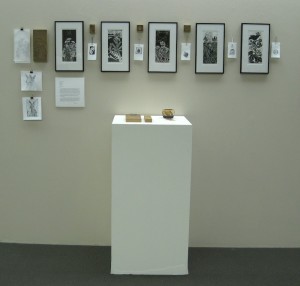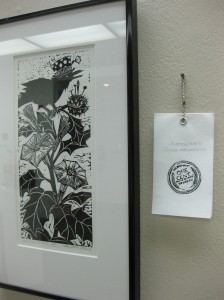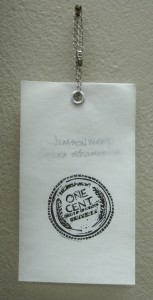The following statement and notes accompany the print series, As Potent as a Charm, in the current Summit Artspace Gallery exhibit, First Impressions – Celebrating the Process of Printmaking.
Hot as a Hare
Blind as a Bat
Dry as a Bone
Red as a Beet
Mad as a Hatter
There’s a bit of whimsy in this mnemonic of the symptoms that, in combination, could indicate an atropine overdose – possibly the effects of ingesting poisonous members of the nightshade family, Solanaceae, which includes Jimsonweed, Henbane, Belladonna and Mandrake. While there is little that is whimsical about poisoning, there is definitely plenty of drama and mystery in horticultural mishaps and misdeeds. Lovely plants may be leading double lives; happy blooms and tasty vegetables have cousins that are downright deadly. Herbalists differ on the merits and dangers of various herbs. The fascinating stories from botanical history, folklore and science invite and inspire imagery.
These are the first prints of a new series titled, As Potent as a Charm, a phrase taken from Nathaniel Hawthorne’s story, Rappaccini’s Daughter. An amulet accompanies each image, although the best luck comes from never, ever ingesting unknown specimens.
The exhibited pieces are linoleum block prints. The initial drawing and design decisions are a large part of the process – determining the balance of light and dark and the ‘readability’ of the work is integral to the success of the final image. After the drawing is reversed and transferred to the block a variety of tools are used to cut the surface, leaving only the area to be printed. The relief prints in this series were hand printed with oil-based ink on Strathmore 500 Series vellum paper.
Notes on ideas and imagery . . .
As Potent As a Charm
In Nathaniel Hawthorne’s story, Rappaccini’s Daughter, the title character, Beatrice, tends her father’s botanical collection of lovely, yet lethal plants. While ‘as potent as a charm’ refers to the specimens, it could just as well describe Beatrice who, as the story progresses, becomes just as lovely and lethal as the flowers she nurtures.
Hot as a Hare
H is for Hemlock? The savvy hare would never mistake Hemlock (Conium maculatum) for its relatives in the parsley family: caraway, fennel, dill and carrots. Besides, he has the luck of four rabbit’s feet.
Blind as a Bat
Native to eastern North America, Bloodroot (Sanguinaria canadensis) has been used by Native Americans for its curative properties and as a dye. Its juice is not only red, but also poisonous. As an ornamental plant it is desirable, blooming very early in the spring. And that bat flying overhead . . . although some consider it a talisman, one can never be sure – those who fear Bram Stoker’s creations should carry some garlic when looking for Bloodroot after dark.
Dry as a Bone
Fiddleneck (Amsinckia menzies) is considered an invasive in desert locales and can be deadly to foraging livestock.
Red as a Beet
There are numerous literary references to the Mandrake (Mandragora officinarum) in volumes as diverse as the Bible, Shakespeare’s plays and Harry Potter. It’s hard not to be intrigued by the Mandrake, who, when its roots are unearthed, emits screams that kill all who hear them – better have some powerful Mojo in your possession should you be within earshot. With the exception of its fruits, all parts are poisonous.
Mad as a Hatter
The mercury once used in the manufacture of felt has been attributed to the madness that inflicted hatters, but the overall craziness could also be symptomatic of poisoning from Datura (Datura stramonium). Its other name, Jimson Weed, shortened from Jamestown Weed, refers to the Virginia settlers who dosed the invading British soldiers’ food, causing them to behave like lunatics for days while the colonists regrouped.
Only Red as a Beet and Mad as a Hatter actually refer to plants that contain atropine (Mandrake and Datura, respectively).
Delving into the botanical dark side has been engrossing, and there are so many more bad seeds . . . lately I’ve been thinking about Monkshood and its Aconite family, the bane of wolves, leopards and women, along with the Castor Bean plant (ricin?!) and that holiday favorite, Mistletoe!
~ Joan Colbert 2013
-
Pingback from artHound · As Potent as . . . Poison, cont. on November 6, 2013 at 9:45 pm





1 comment
Comments feed for this article
Trackback link: https://blog.joancolbert.com/potent-as-a-charm-statement-notes/trackback/